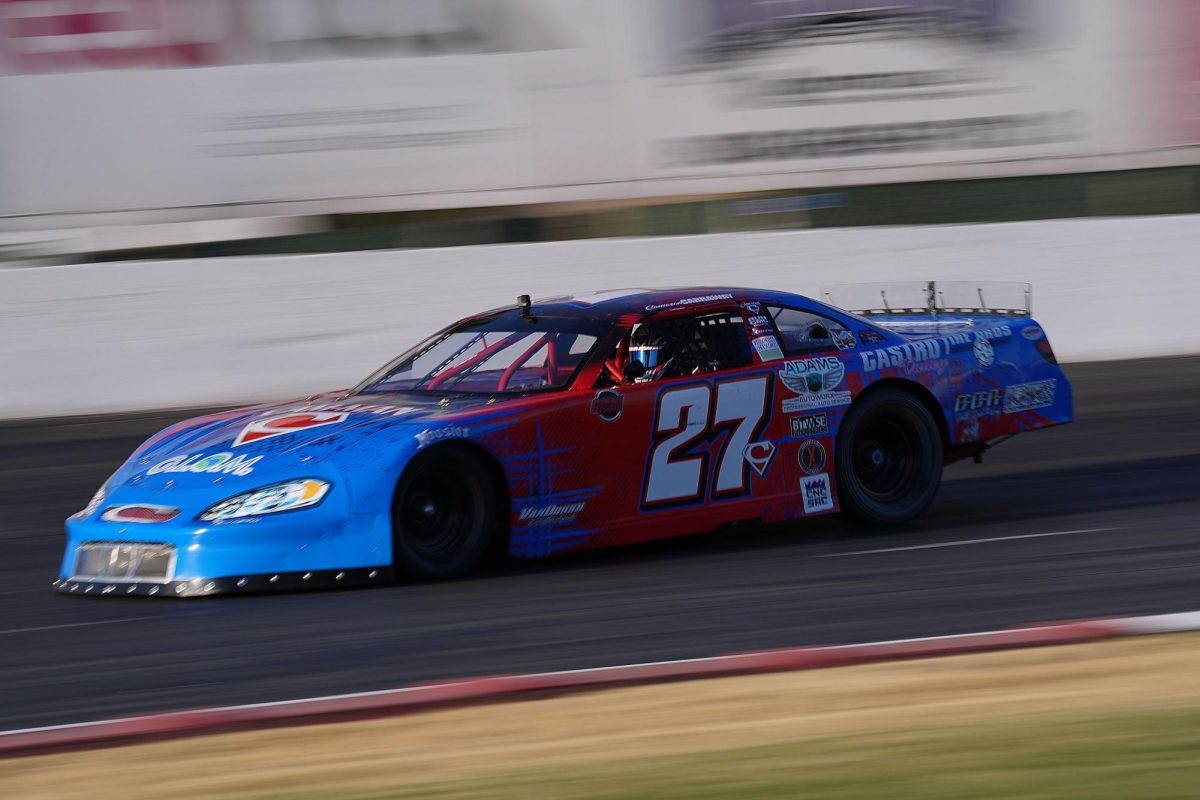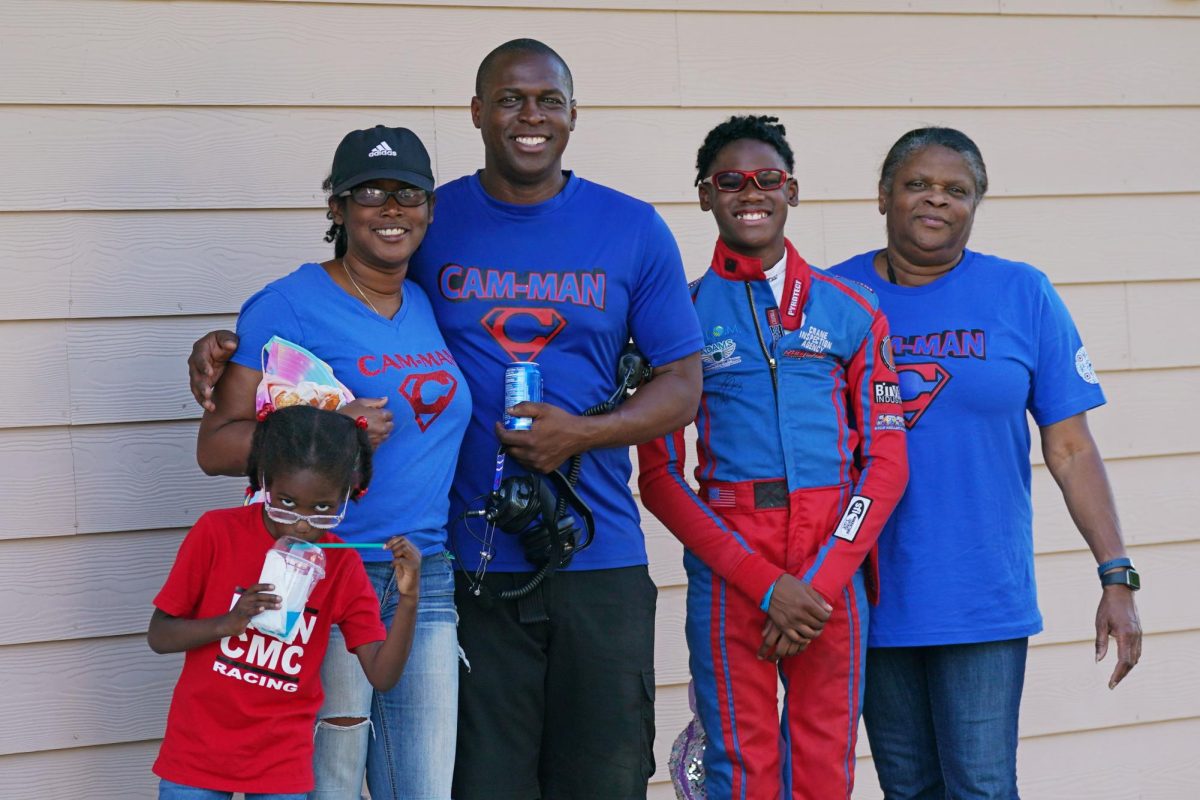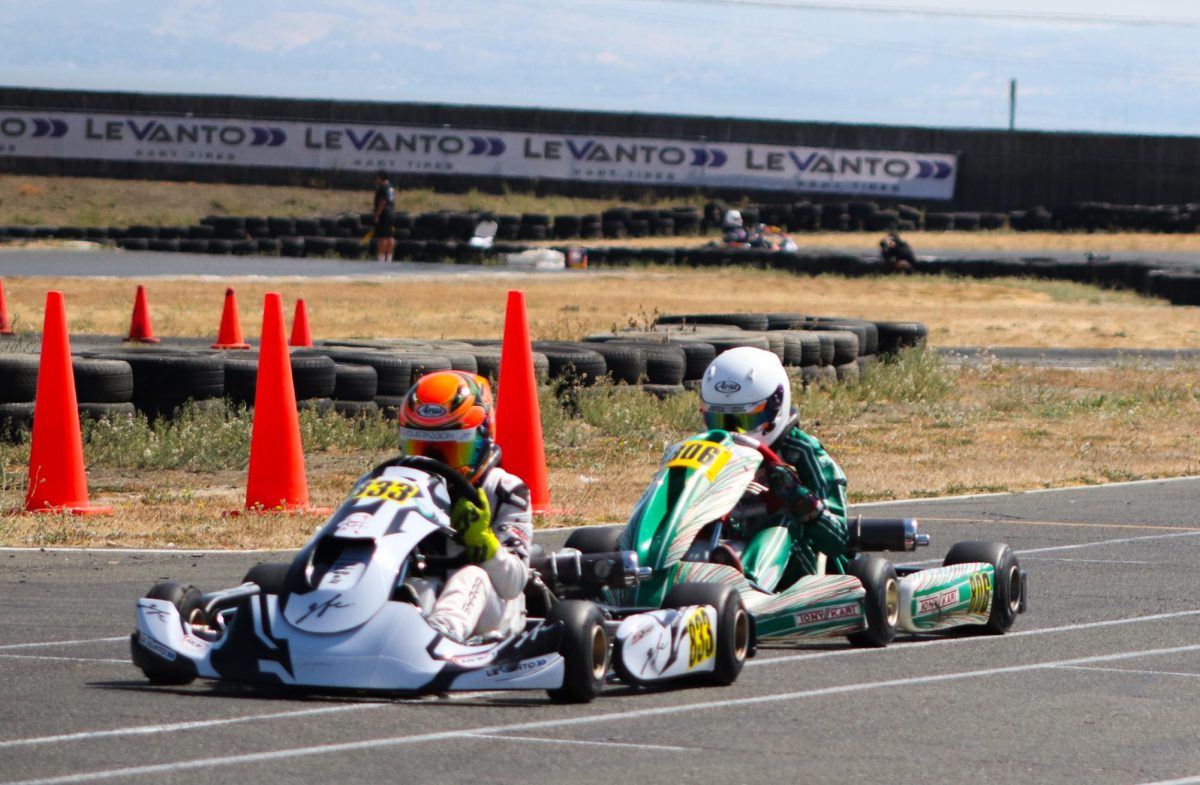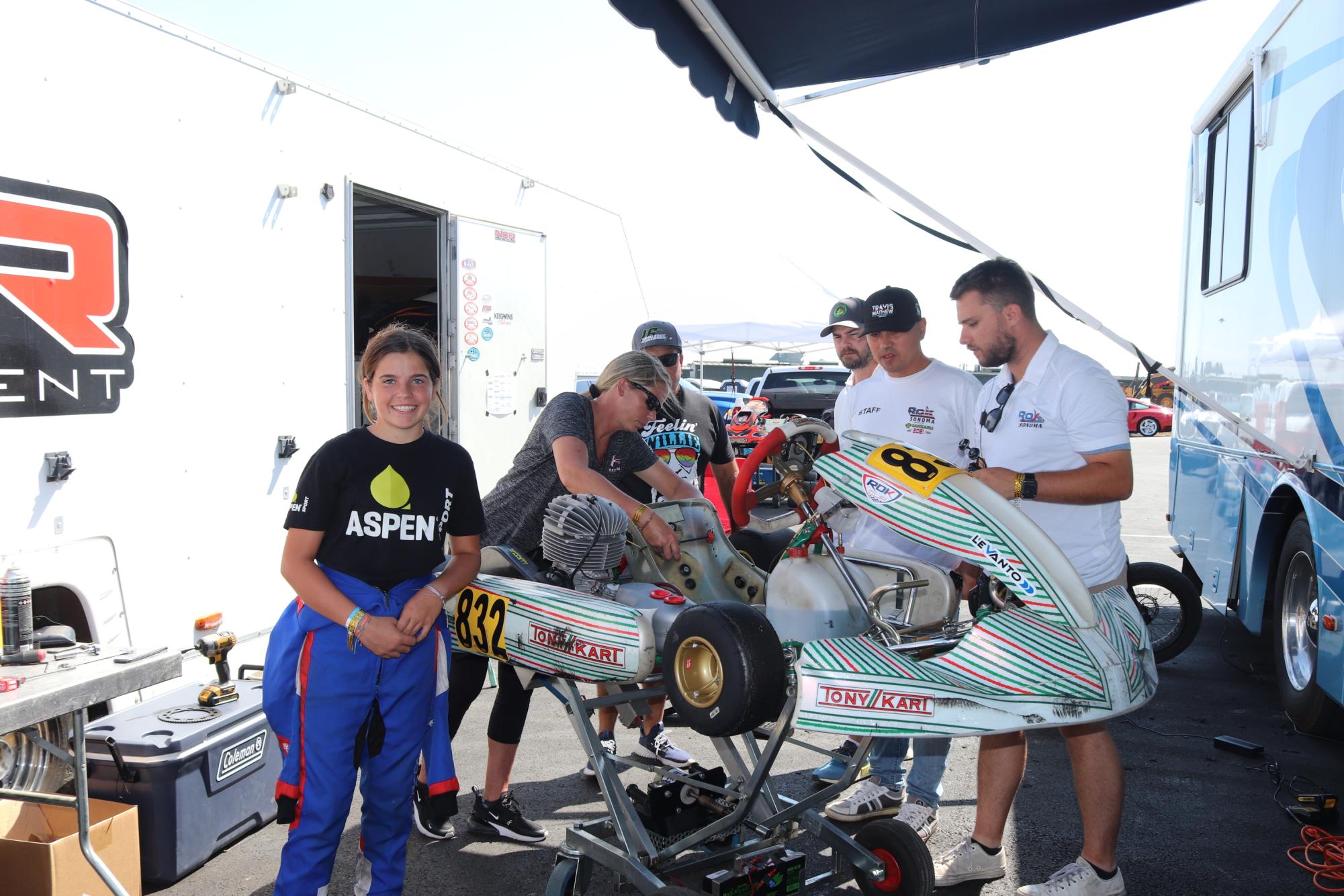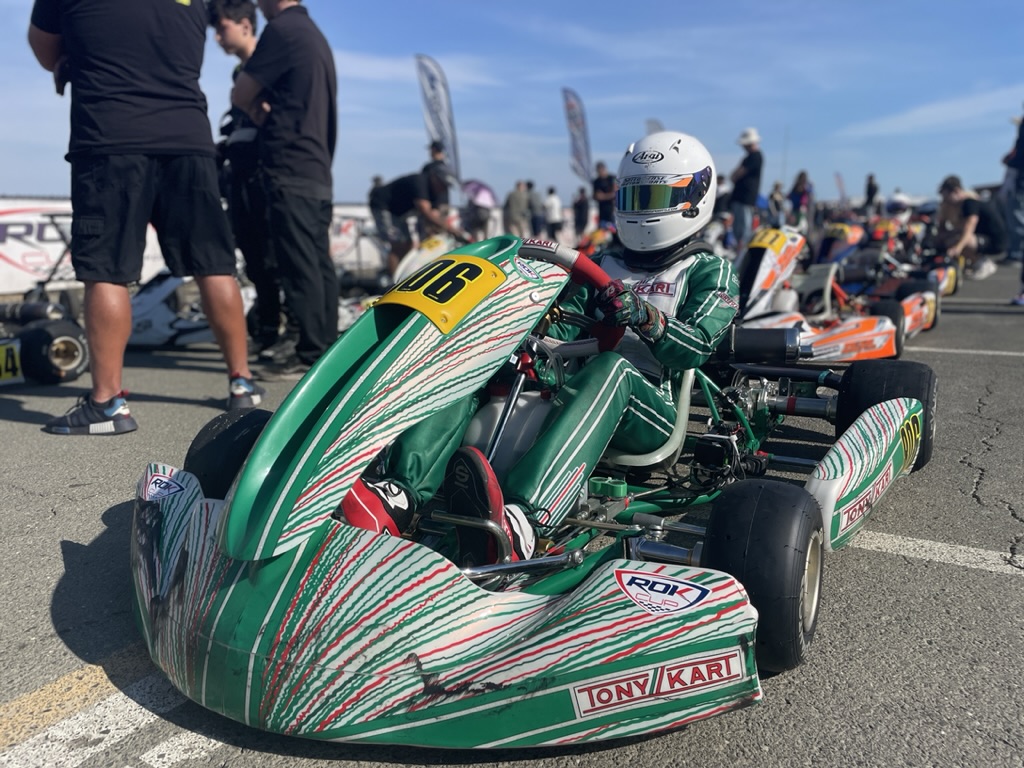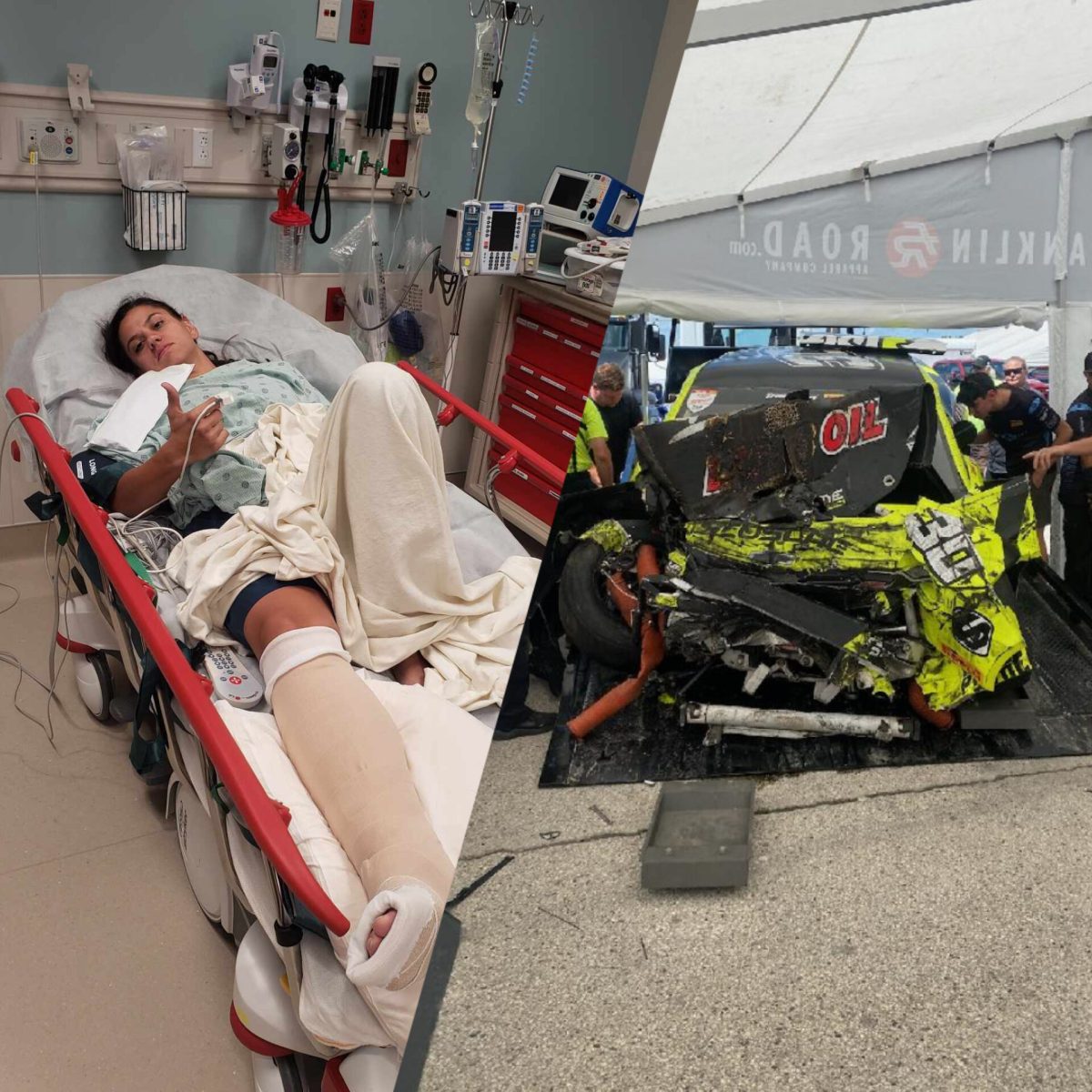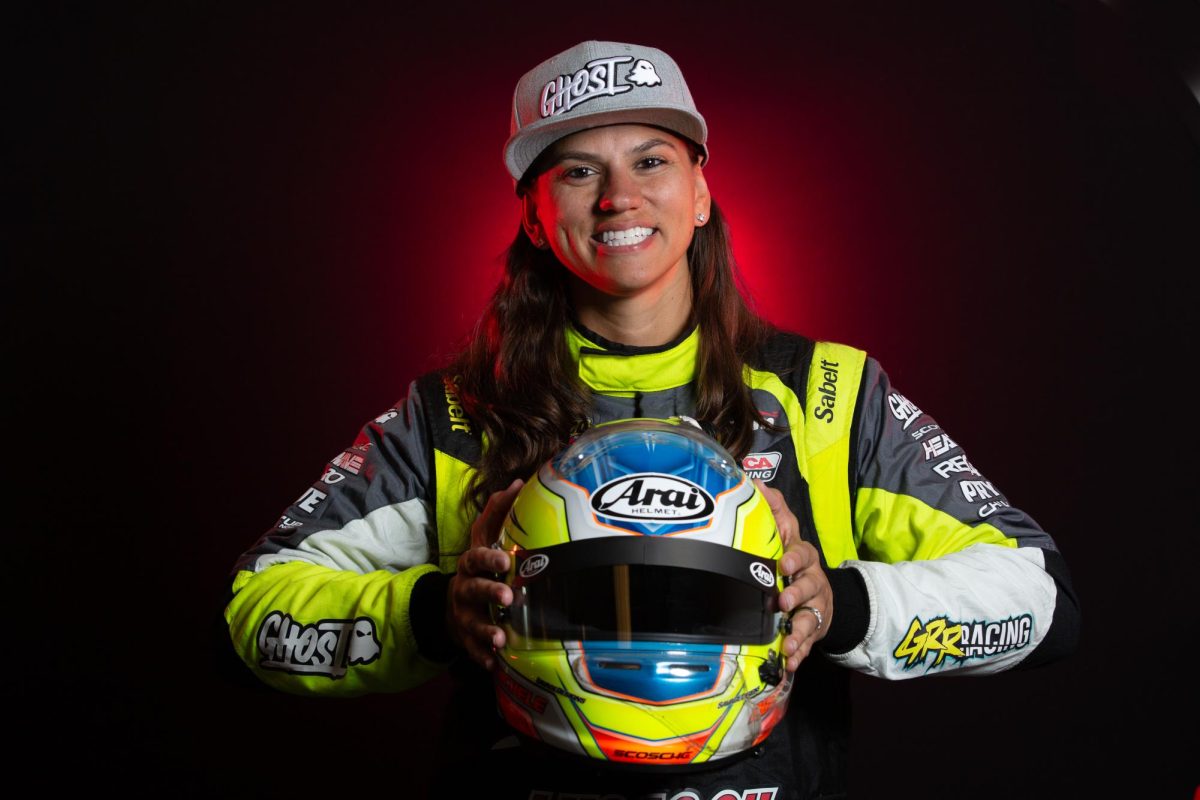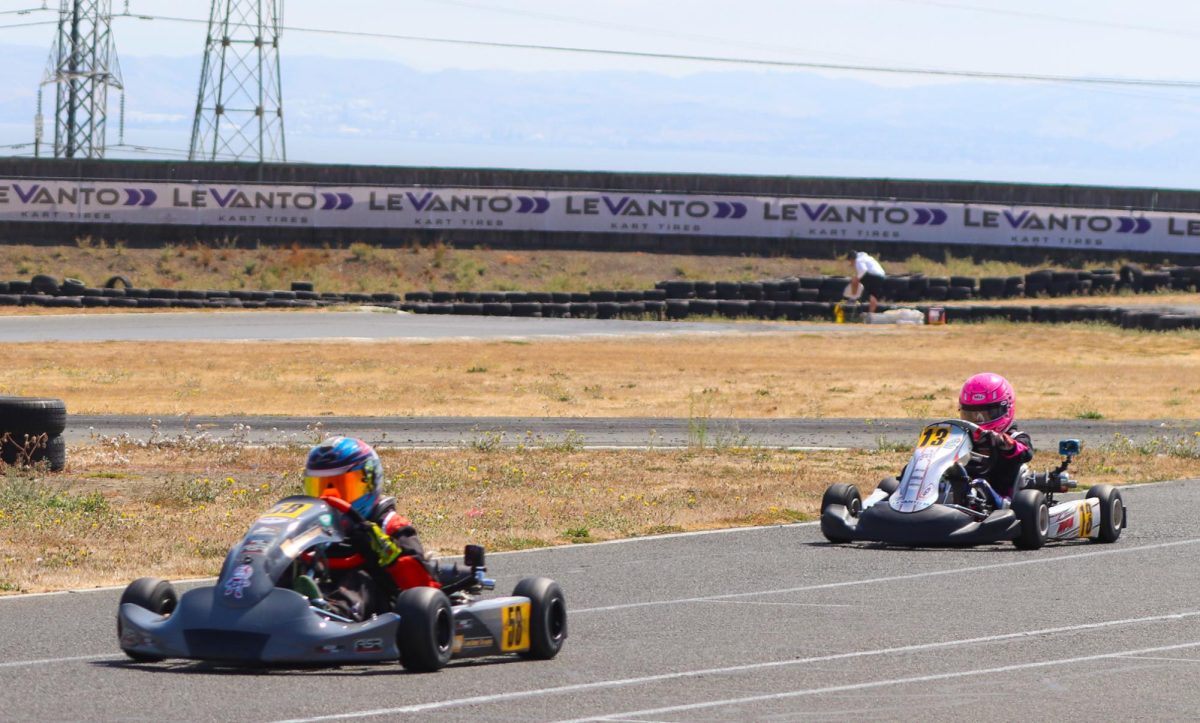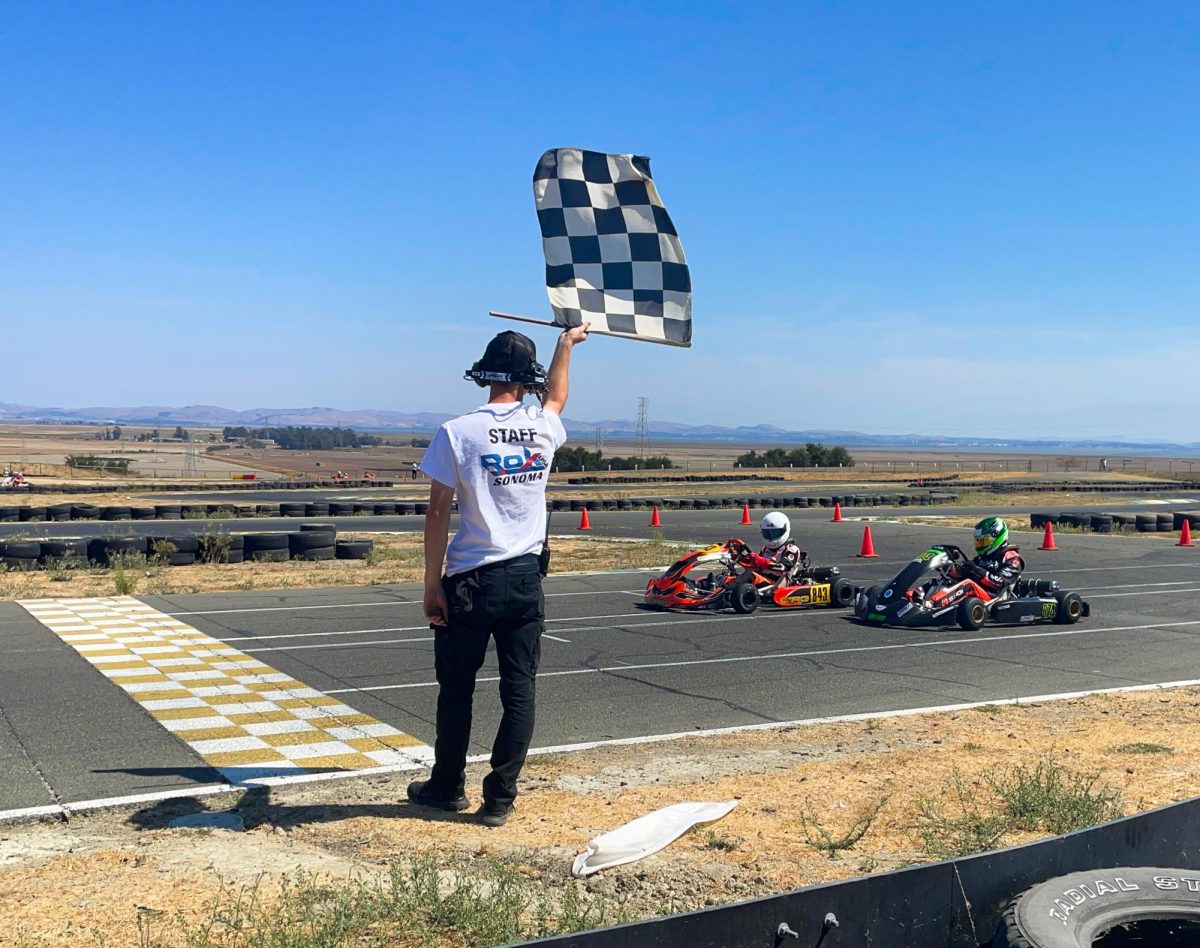Getting on track
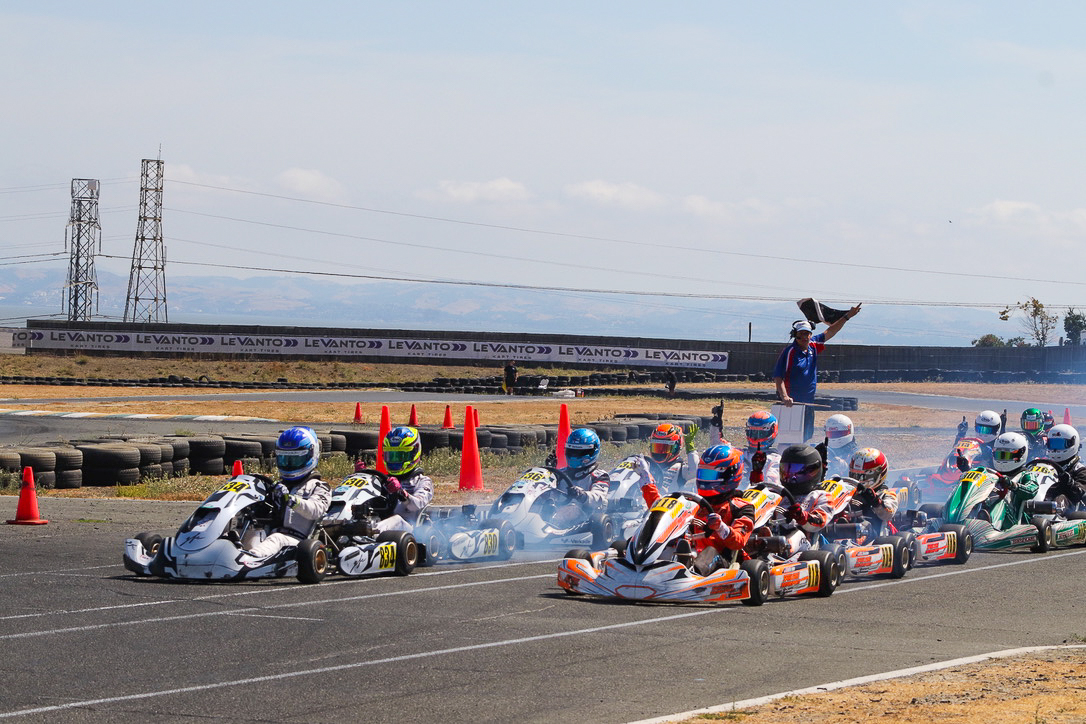
You can hardly hear your own voice over the roaring engines. The smell of motor oil and burnt rubber is everywhere, but so is an air of excitement.
Welcome to the world of motorsport.
While most people get their driver’s license at 16, in racing, children as young as 8 can race at speeds exceeding 50 mph. The fastest go-karts can reach 150 mph.
via GIPHY (Elaine Jiang) Competitors race towards the finish in the Senior VLR Pre-final at the ROK Fest West karting event. Listen to this clip to experience the noise of a karting track.
According to Sports Illustrated, motorsport has increased in popularity in recent years, due in part to the success of the Netflix show Drive to Survive, which focuses on the behind-the-scenes of the racing series Formula One.
Monika Mukerji, a junior, initially fell in love with the sport through Drive to Survive and she hasn’t looked back since.
“Racing is such a unique sport that is very exhilarating to watch. It’s almost addicting and even if you’re not into cars, you can really get into it because you will want to know what happens to each driver and to each team since it’s very dramatic,” Mukerji said.
Mukerji and others like her represent how the fanbase of the sport is diversifying. According to Stefano Domenicali, the President and CEO of the Formula One group, women now constitute about 40% of Formula One fans, which is five times the 8% they represented in 2017, just six years ago.
This has led to growing demands for a more diverse industry. Despite its long history, motorsport has been slow to make strides in this regard — Formula One only had its first Black full-season driver in 2007 when now seven-time F1 world champion Lewis Hamilton debuted, and there has not been a female driver to race in an F1 grand prix since Lella Lombardi in 1976, almost half a century ago.
“Someone who is a woman, a woman of color, a person who is disabled, or a person who is queer — they’re not seeing themselves represented. So of course, the natural thing for anyone to think is ‘This is not a place for me,’” said Anna Tarkov, an F1 fan and the former host of the now-defunct podcast Racing Incident. “A lot of it is that vicious cycle of when you have people in charge, who are not themselves a diverse group of people, the lack of diversity will perpetuate itself. I’m hopeful that the work that’s being done now will someday lead to a female team principal (boss).”
Tarkov started her podcast because she saw a gap in the landscape of Formula One content when she became a fan: female-driven podcasts. According to Tarkov, it was incredibly hard at the time to find content made by women, for women, or content that discussed the politics and structural inequities of Formula One.
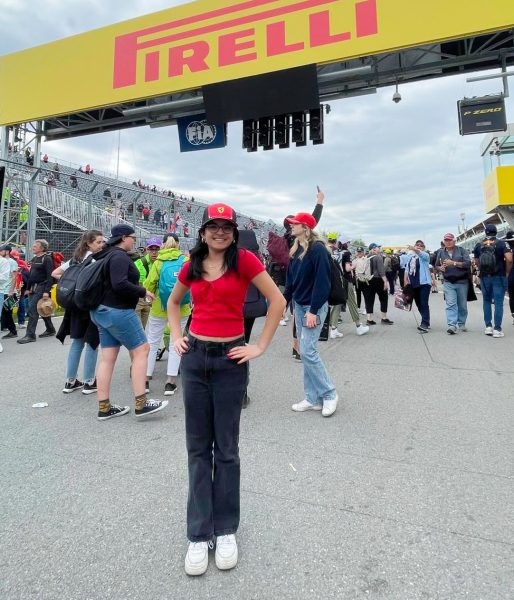
“People think that it’s impolite to talk about politics, or that politics is some separate realm of life. I’ve always said that the people who want to keep politics out of the conversation are the people who are not affected by it. They just want to stick their heads in the sand and pretend there aren’t any problems. It’s immoral and unethical to do that, in my opinion,” Tarkov said.
A more diverse fanbase also means that people are starting to call out the problematic behavior of some people in the industry, behavior that might have previously been brushed under the rug.
Helmut Marko, the head of the driver development program at Red Bull Racing, the team that won the 2021, 2022, and 2023 F1 championships, recently came under fire for insensitive remarks he made about one of Red Bull’s drivers, Sergio “Checo” Perez. His comments implied that because Perez was “South American” (despite the fact that Perez is from Mexico), his heritage was influencing his poor performance.
Marko has since apologized and been reprimanded by the International Automobile Federation (FIA), which governs F1, following intense backlash from fans.
“The only reason the FIA reprimanded him is because there was a lot of outcry, so things are changing positively. In the past, no one would have said anything because that fan base was less diverse. There were a lot more people who just accepted that the sport was very Eurocentric, and believed ‘Oh, well that’s the way it is,’” Tarkov said.
However, in order to promote further diversity in the sport, Tarkov believes that “you have to start at the grassroots level.” Examining the grassroots of racing requires taking a look at the entry levels of motorsport, where kids learn how to drive and begin competing.
Cameron “Cam” Carraway dreams of being a NASCAR driver.
“Ever since I was born, I’ve always loved it. I’ve always wanted to make it a career and we ended up finding that pathway through quarter midgets and ever since then, it’s always been my passion to try and make racing my career.”
Carraway, now 13, has been driving since he was 6 years old. In that time he has become a two-time national champion in quarter midgets, a type of racing car designed for younger drivers, and broken numerous track records.
“A favorite memory of mine was the state championship because it made me feel really accomplished, especially knowing that I was the first African American to ever win. Not even just one state championship, but two,” Carraway said.
Carraway acknowledges that at the track, there is something to be desired in terms of diversity.
“At a local racetrack, you will most likely see me as the only person of color. There are a few girls but other than that, there is not much diversity at all.”
Being one of the first Black drivers to accomplish so much in racing at such a young age is a point of pride for Carraway, but it’s not what he focuses on.
“No matter what your race or gender is, we do the same thing. We’re going around on a racetrack that has straights and corners. So I typically just set that aside because I’m going to race like everyone else and I deserve to be here,” Carraway said.
His parents also attempt to protect Cam from any racism or negativity.
“With him racing, or anything he will be doing in life, it is a component of the experience of being a male person of color that is successful on some level. Yes, it does occur, but we just try to shield and delete as quickly as possible and move away from it,” said Ray Carraway, Cam’s father.
Carraway is managed by his parents, April and Ray Carraway. There is much more to racing than just driving the car, so Cam’s mother runs his social media, while his dad acts as his mechanic and spotter, the person whom he communicates with on the radio.
“We both work full-time and then managing Cam is our second full-time job. It is a lot of work in the background. Nearly every weekend we’re involved in some sort of racing activity or promotional event and it’s been this way since he was 6. It’s been a lot of work over the last few years but he’s excelling so much that that becomes the motivator: to see him continue to succeed.” Ray Carraway said.
Sacrifices come with the territory though. Missing school for races means that Cam must spend time completing make-up work and may need to be homeschooled to race at higher and higher levels through high school.
“We’ll have to make a decision by the end of this year on his homeschooling because he’ll be going into high school and they’re not as lenient—his middle school understands what he’s doing, but the high school isn’t gonna care,” April Carraway said.
For Cam though, almost anything is worth it to race or even to just be surrounded by the cars.
“Even if some crazy, catastrophic incident happens and I can’t make it into NASCAR, I’m still gonna try to be involved in the sport—commentator work or something else. I love seeing those cars go around the track. I just love it so much,” Cam Carraway said.
Listen to the full answer through the clip.
Gabby Guidera dreams of being a Formula One driver.
Last year, at age 13, she became the first girl to win a karting championship at Sonoma Raceway, a historic track in Sonoma, California that has hosted NASCAR and IndyCar events. Guidera won the Mini ROK Karting championship and defied expectations and stereotypes in doing so.
“They think that just because I’m a girl, I’m not more aggressive than them but I showed them last year,” Guidera said.
Now, she races in Junior VLR, a higher class with faster top speeds. VLR refers to the engine in the kart, which has a higher engine displacement or capacity of 100 cc (cubic centimeters) compared to the Mini kart engine. This allows the engine to process more gas and air at a time to be converted into power for the kart.
“It gets harder as you go up the series. In Mini, not everybody was fast, but now almost every single person on the track is competitive, and then in Senior VLR, everybody is going to be super quick,” Guidera said.
However, racing cars also means crashing occasionally. Once, at Homestead-Miami Speedway Guidera was distracted and ended up hitting the barriers.
“I missed my braking zone and went straight into the wall. I couldn’t move three of my fingers for probably five minutes, because I hit my arm on the motor so hard. I lost feeling in all the nerves in my arm. But other than that, it was not that bad,” Guidera said.
Often it is much worse for the parents watching.
“It’s very nerve-wracking. I’ve seen my son in plenty of nasty crashes and it doesn’t stop him from racing. I’m shaking all the time, just ready for the race to be over,” said Lindsey Guidera, Gabby’s mother.
Being the only girl on track can be difficult.
“None of the boys want to get beat by a girl, so I feel like there is that ‘they’re out to get her’ factor. Off the track, they’re all great friends, but on the track, there is this sense of ‘I’m not going to let her beat me.’ So I feel like they’re a little bit more aggressive than what she is,” said Ashley Johnson, the mother of Kylie Johnson, 9, one of the only girls who races in the Micro ROK category. Kylie, too, dreams of making it to Formula One.
Many kids in karting share Gabby and Kylie’s dream of racing at the “pinnacle of motorsport,” but the road to get there is impossibly competitive.
“You want to be a racer, but I kind of knew that wasn’t going to happen. It’s not a self-deprecating thing, it’s just there are only 20 racers in the world who do Formula One. Even for Formula Four (a feeder series), you need a lot of money to do one season. Not to mention if I wanted to try to go down that path, I would have to take a lot of time off school and that’s not something like my parents would be willing to allow me to do,” said Yana Kapoor, a 16-year-old junior at Saratoga High School who races in the Senior VLR category, a step above Junior VLR.
Kapoor used to live in Indiana where she and her brother were some of the only people of color to race. In northern California at Sonoma, it is more diverse, but Kapoor doesn’t see gender or racial divide as an isolating factor.
“What the status quo or people outside the racetrack on social media will say might make girls not want to come out and race, but if you’re actually in motorsport, everyone respects you based on whether you are a good driver or not, not on your gender,” Kapoor said.
And there are many good female drivers.
“A lot of the other girls that I see win most of their races. It’s just there’s not that many girls that race, so you don’t see it as much,” Kapoor said.
Kapoor knows she will graduate and go to college soon, where she won’t have much time or opportunity to compete anymore. As a result, she’s more focused on enjoying karting and her remaining time at the track, which she says is also important to doing well in the sport.
“That’s the key, all the people who perform at the top level are always having fun, always with their friends, laughing and having a good time. I genuinely feel like if you’re just having a lot of fun, then when you go on track feeling happy, you just do well,” Kapoor said.
-
Gabby Guidera stands next to her kart as her mother, Lindsey Guidera, tinkers with it. Due to her success, Guidera was invited to test an F4 car in Indiana. It gave her experience with paddle shifting and karts that were more tricky to drive. Paddle shifter karts have gearboxes that require the driver to click a paddle on the side of the steering wheel to change gears. These karts produce faster top speeds and are for more advanced drivers. “It was definitely a lot more difficult than a go-kart because the steering was definitely way harder. There's a lot of G-force when you go into the corners and my neck was resting against the car. But, it was super fun,” Guidera said.
-
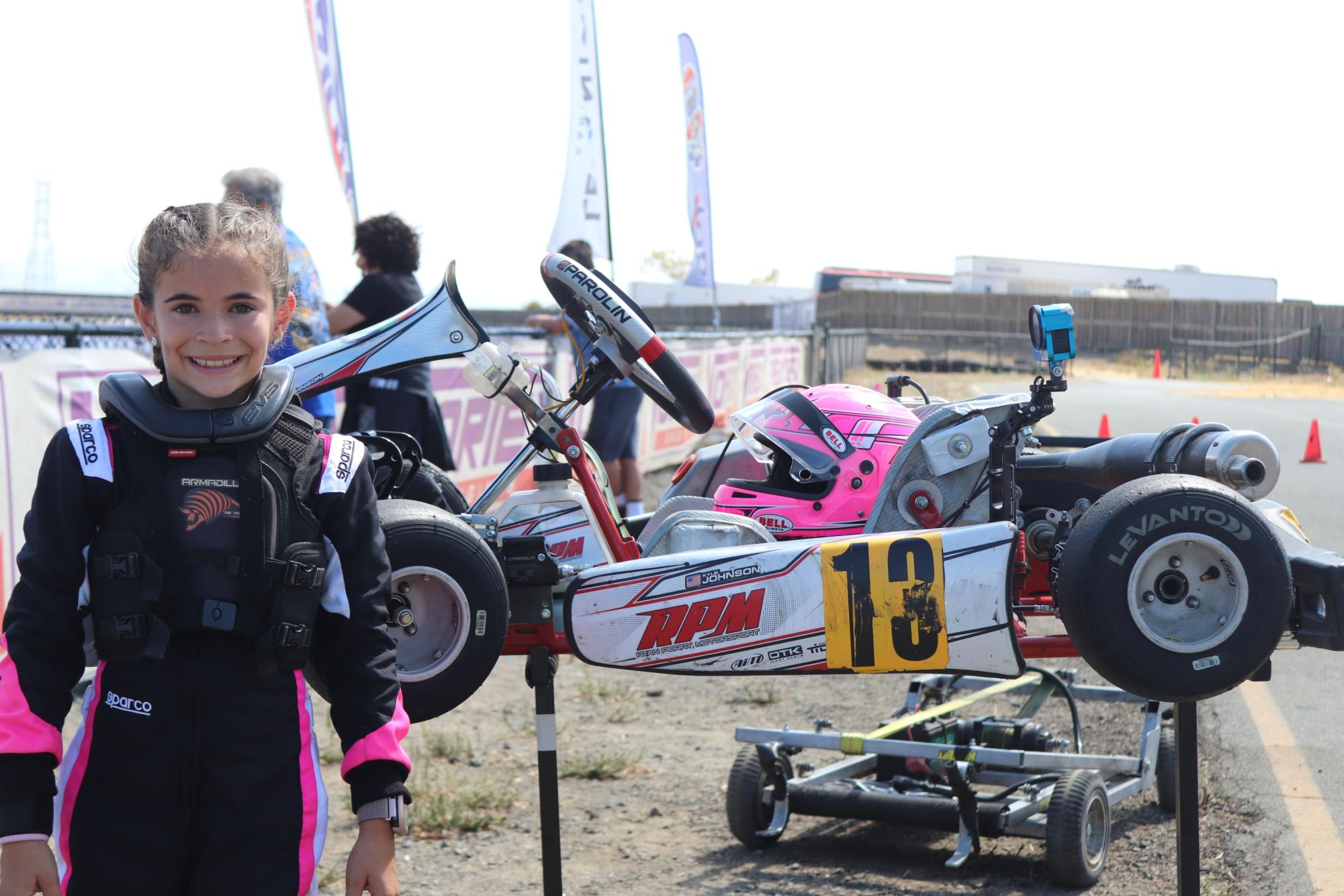 Kylie Johnson with her kart, complete with a neon pink helmet. She loves the speed of karting (and beating out the boys she competes with too). “I want to get to F1 and be the first girl,” Kylie said. (Elaine Jiang) (Elaine Jiang)
Kylie Johnson with her kart, complete with a neon pink helmet. She loves the speed of karting (and beating out the boys she competes with too). “I want to get to F1 and be the first girl,” Kylie said. (Elaine Jiang) (Elaine Jiang)Kylie Johnson with her kart, complete with a neon pink helmet. She loves the speed of karting (and beating out the boys she competes with too). “I want to get to F1 and be the first girl,” Kylie said.
-
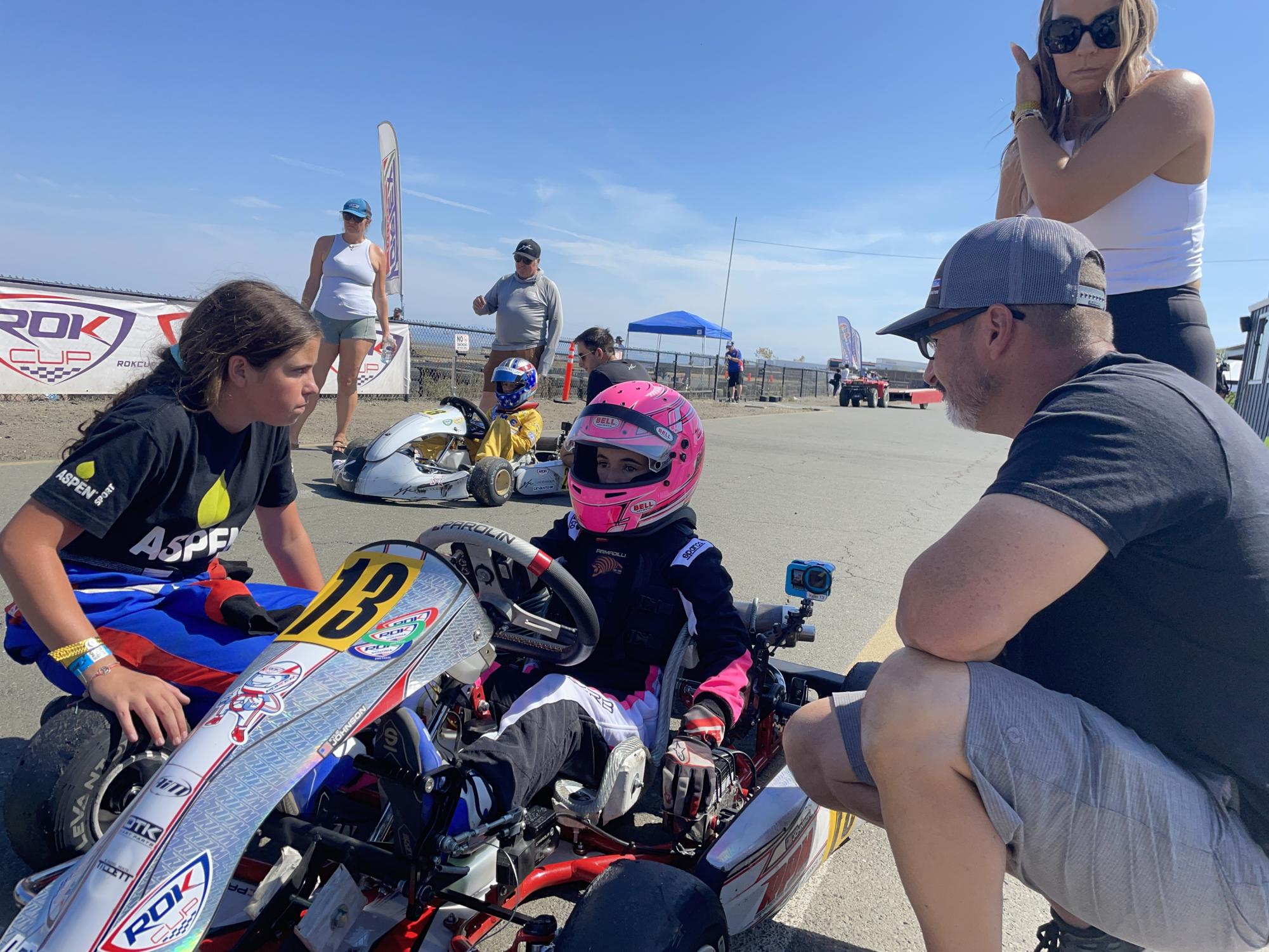 Right before the start of the race, Gabby Guidera and Kylie’s parents give her a pep talk and some encouragement. Kylie has been racing since she was 6 and in that time, her parents have had to learn how to do everything in order to get Kylie out on track on the weekends. “We are our own team: we’re mechanic, we’re the food prep, we’re the coach, so it’s a lot of work as parents but as long as she wants to do it, we’re gonna continue to give everything we have to it,” Ashley Johnson said. (Elaine Jiang)
Right before the start of the race, Gabby Guidera and Kylie’s parents give her a pep talk and some encouragement. Kylie has been racing since she was 6 and in that time, her parents have had to learn how to do everything in order to get Kylie out on track on the weekends. “We are our own team: we’re mechanic, we’re the food prep, we’re the coach, so it’s a lot of work as parents but as long as she wants to do it, we’re gonna continue to give everything we have to it,” Ashley Johnson said. (Elaine Jiang)Right before the start of the race, Gabby and Kylie’s parents give her a pep talk and some encouragement. Kylie has been racing since she was 6 and in that time, her parents have had to learn how to do everything in order to get Kylie out on track on the weekends. “We are our own team: we're mechanic, we're the food prep, we're the coach, so it's a lot of work as parents but as long as she wants to do it, we're gonna continue to give everything we have to it.”
-
Yana Kapoor lines up on the grid, preparing to head out on track. Karting is something she decided to take seriously more recently, which is when she started noticing improvement in her times. To race well, Kapoor says, requires a large amount of concentration. “Racing is mainly a mental game. When I’m not in the right mindset or I'm thinking about too many things, I’m gonna be really slow,” Kapoor said.
Not everyone, however, starts in motorsport as a kid in karting.
Tati Ziemer didn’t grow up racing, it’s something that she took up later in life.
Her first track day at Thunderhill Raceway Park almost made her not want to come back. Just wanting to make sure she enjoyed driving before investing more money into upgrading her car, Ziemer brought her Subaru with regular street tires and brakes. Some “canyon kids,” or a group of boys who race around canyon roads, started taunting her about her equipment, which made for a discouraging experience.
“I ended up posting something on Facebook afterward saying, ‘Oh, I had an interesting experience, does anybody have any advice for somebody that wants to try again?’ and they harassed me on the post, tore me apart, and tried to tarnish my name. Every time I posted on this Facebook group, these canyon kids would come and try to drag my name through the mud to the point where I’ve had to contact the admin about it,” Ziemer said.
Female drivers often receive online abuse. Under the comments of many posts of female drivers and their achievements, some motorsport fans take it upon themselves to write messages about how women don’t belong in the sport or are too biologically inferior to compete in the same categories as men.
“It’s unfortunately really common. It’s not just me, you could go through any female pro’s comments and just see derogatory stuff, even sexual stuff. I mean, sometimes we’re like objects to men and it’s very sad,” Ziemer said.
Michele Abbate, a professional driver who races in the TransAm TA2 class, shared this experience. She suffered a rough crash recently that forced her to have ankle surgery. Posting about it drew insults in the comments, but for Abbate, it’s important to ignore the hate and focus on winning instead.
“I feel like as a female driver, you have to have thick skin. With my incident, I posted it online because there’s things to learn from it and men left stupid comments like ‘Oh, you drive like a girl’ or ‘girls shouldn’t be racing.” It’s all because I’m a girl, but I don’t even care, I think it’s so stupid,” Abbate said.
Additionally, research from the More than Equal Initiative, which was co-founded by 13-time F1 race winner David Coulthard and aims to develop female motorsport talent, found that women do not progress up the ranks of the sport at the same rate as men, with female drivers representing only 4% of top talent. They are also almost twice as likely as male drivers to drop out within the first five years.
The problem partly lies in a smaller pool of female participants at the sport’s entry levels, lower series such as mini karts and quarter midgets like what Gabby Guidera and Cam Carraway started out in while they were still in elementary school. In order to fix this, there needs to be more awareness and female interest.
“We had a group come out to the track from Sonoma Valley High School and it was great. They brought out a whole group of girls to kart and at the end of that day, I realized you have to bring out girls that are actually interested in motorsports. We can’t just take girls and try to force them into it, they have to have that interest first. We just need to show girls that this exists. A lot of them don’t know that they can race cars,” Ziemer said.
Representation also matters. If more women are represented in the sport, young girls will be able to look up and see their path forward in the sport too, according to Abbate.
“Unfortunately, for my category, I’m the only woman that’s ever full-time ran in it. There is always room for more women in the sport though. I think the more women see other women doing it, then they get the idea that maybe they want to try it,” Abbate said.
Both Ziemer and Abbate also acknowledged the more general problem of the lack of information surrounding how to get into motorsport and advance through it.
“In the United States, there’s not really a ladder system in my opinion. Even karting, especially now on the West Coast, is really dying, so the entry-level for motorsports is simply dead. You have to be on the East Coast to be competitive in karting and make something of it. That’s a big thing is the lack of awareness around where to start,” Ziemer said.
It’s not hard to see this difficulty in real life. Any Google search about karting or other lower levels of racing quickly leads down rabbit holes about racing clubs and necessary equipment, often with hard-to-understand mechanical jargon that can overwhelm people with no prior knowledge or background in automobiles. There is also little information about how to advance, especially to the professional level.
“If you’re new to motorsports and you want to start racing, there’s no information out there on how you do it. That’s probably what was the biggest struggle: I didn’t understand the ladder, where I wanted to go, or even the differences in discipline. There are so many things to consider and I almost feel bad for the people that don’t have even the slightest clue of the different categories of racing,” Abbate said.
Additionally, racing is a physically difficult sport, leading to a widespread misconception that girls are too physically limited to compete at the same level as men in motorsport.
“It can get up to 150 degrees inside the cabin. My right shoe has melted because it’s so hot in there. On top of that, it’s a big heavy car, so with manual brakes and steering, you’re using a lot of chest and arms. I’m pretty strong in my upper body but it’s very physically demanding in every aspect, especially mentally. Racing is 70% mental, you have to stay super strong and concentrated,” Abbate said.
However, the notion that women are physically inept to compete against men has been proven false. According to other research from the More Than Equal initiative using data on the benchmarks of performance for Formula One drivers, there is no reason women cannot reach these same benchmarks to compete with men.
Abbate also believes that a key part of earning respect as a female driver is being honest about the results and struggles of competing.
“I truly think I have a lot of respect on the racetrack because I don’t hide behind my results. I’m very upfront about how I’m doing and I don’t care about trying to represent someone I’m not. I haven’t won a race. I haven’t finished in the top 10 in the last two years. It’s important to share that side of the story, the downfalls and the lack of success, because if you act like everything is great, that’s where the disrespect comes from,” Abbate said. “I don’t like seeing women who don’t do well and they act like they’re doing great. It’s a false advertisement.”
Motorsport offers one of the few opportunities for a level playing field between all genders, which is why it is frustrating for some female drivers to see women in the sport separated into female-only series such as the W Series and new F1 Academy, which intend to increase visibility for female talent.
“With the W Series and F1 Academy, I get what they’re trying to do in the sense of getting eyes on women in motorsports, providing them an opportunity, and then helping them get to that higher level, but I don’t care for segregated racing. I think in the professional levels of racing, it’s much better to have a co-ed grid. It proves that women can race like men. I love racing against the men and I think that it makes me a better driver. It also helps other men realize that women can compete, which is super important,” Abbate said.
Listen to the full conversation in the podcast episode above.
There is another struggle for drivers that transcends racial or gender lines: the lofty price of racing.
“The high cost is the biggest thing. It’s less and less about being the fastest driver nowadays and more and more about what you can bring to the table as a whole. Results matter to a certain level, but if you have a massive social media following and can offer tons of value in different ways, then you don’t really need to rely on the results,” Ziemer said.
Even just starting out can cost a fortune, holding back interested people from entering the sport.
“The cost of entry is big. Just to get my license, the schools I had to do were 15 grand total. And that just gets me a race license, it doesn’t include the actual racing or anything like that,” Ziemer said.
The price varies widely depending on what kind of vehicle and class a driver races in. For a go-kart, the cost of the engine and chassis each run easily into the thousands. Combined with maintenance, tires, fuel, and gear, the first year of competitive karting can cost around $11,000.
“The kart was about $7,000. A weekend can easily run around anywhere from $1,000 to $2,000. And then there are parts to change and services. If I want a driver to go on track with my kid, it adds more,” said Malkesh Adesra, the father of Neev Adesra, who races in the Mini ROK class at Sonoma.
Adesra also pays additional money for a racing school to help teach his son. Enlisting a school or team for advice can often lead to much better results, much faster.
“A lot of the other kids out here, they pounded around the racetrack for three or four years before they figured out the little sweet spots of the track. For our kids, the first kid that we ever worked with in the Micro category came in third place in the championship in his first attempt,” said Jason Shadd, a former semi-pro racing driver and the founder and owner of SSi Racing Team, which offers coaching to people looking to get into motorsport. Their starter package is priced at $320 for four hours of simulation training.
Furthermore, the cost rises at higher, faster, and more competitive levels, making it harder to progress through the ranks.
“You could run $3,500 for a dirt cheap, grassroots weekend. Next year, with the series I’m trying to do, just the car alone is 12 grand a weekend. The differences in the series as you step up from a club to a regional competition almost doubles and triples in weekend costs,” Ziemer said.
When renting a car, the driver is often held responsible for any damage and repairs, which are almost inevitable given the unpredictability of a race and its competitive nature.
“If you crash the car or somebody hits you, and that could be somebody else running into you, you’re liable for that. That’s where a lot of the costs can also come from, totaling your car,” Ziemer said.
The financial toll of competing in motorsport represents a barrier, preventing many from being as involved as possible.
“At the beginning of this year, I was on a three-year plan for this series and I was trying to be super competitive, but I ran out of my own money. The last few months have forced me to be more present and I think the most important thing is to have fun while you’re doing it,” Ziemer said.
In order to pay for their careers, many budding drivers turn to getting sponsors.
“I have a decent plan, but it’s contingent on sponsorship money, so I’m not gonna give up but it is reliant on what I can bring from the outside. This is the reality for not even just female racers, but I would say probably 90%-99% of racers are reliant on sponsorship money,” Ziemer said.
Driver scholarships and grants also exist to provide help to rising talent. Diversity-minded programs such as the International Motorsports Sports Association (IMSA) Diverse Driver Development Scholarship, Parella Motorsports Holdings (PMH) Powering Diversity Scholarships, and Shift Up Now Foundation grants. Abbate has received the latter two and they have made a difference in pushing her towards her goals.
“As a driver and a team owner, what speaks is financial help. Without my partners I absolutely wouldn’t be racing in the category I’m in,” Abbate said.
Even after her multiple partnerships with brands though, Abbate still struggles to turn a profit.
“I still pay out of pocket to complete my racing season. I’m really close to breaking even, but I don’t receive any money from any of my deals. I’ve never raised funding with the intention of taking a salary, only to get me to the racetrack and get me racing. This is something I’ve been struggling with now in the professional category because I’m taking time off work, which eats into my ability to make money outside of the racetrack. I’m starting to build value where I could maybe pay myself a little bit of something per weekend, but right now I don’t make any money,” Abbate said.
However, it isn’t about the money for Abbate. Racing is her passion and her life’s dream.
“I love racing, that’s all I want to do,” Abbate said. “So my husband and I have dedicated our lives to going racing.”
With the high costs and major sacrifices that can come with competing in motorsport, the question remains: why race?
“My heart goes through the roof and it’s so scary, but at the same time, we love it. It’s our favorite family activity,” Ashley Johnson said.
Ashley loves racing because it is a family sport. While it requires much more time and effort, it also allows parents to be much more involved with their children, especially compared to a sport like gymnastics, which Kylie also competes in, where a coach handles everything.
Furthermore, racing offers many life lessons and behavioral benefits to the kids who take it seriously.
“Racing requires discipline. It touches everything from troubleshooting problems to diet, to way of life. It also teaches you to really live in a positive way because you’re spending more time losing than you are winning. Second place is still losing, so you’re learning how to deal with defeat psychologically, and the better you can handle that, the better you can handle life,” Shadd said.
Motorsports can also create a tight-knit community as many people compete against the same people in each race. After her bad experience with her first track day at Thunderhill Raceway, Ziemer said there have been many good moments too.
“It’s series-dependent and organization-dependent, but you can find one where you find your track family. There could be days when your car breaks down and five other people decide to skip out on their session to come help you fix your car so you can make the next session. Everybody is willing to just drop everything and help you, they’re super supportive. There is ego, especially at the more competitive levels, but a lot of the time it’s just a fun community,” Ziemer said.
For many drivers, the feeling of being in the car is enough of a reason.
“Everything else melts away and the only thing you’re focusing on is driving. All your worries, all your thoughts, everything goes away and you’re just present in the moment,” Ziemer said. “There’s nothing else like it.”





